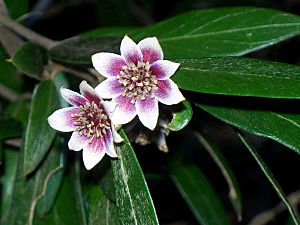Southern sassafrass facts for kids
Quick facts for kids Southern sassafrass – narrow leaf form |
|
|---|---|
 |
|
| Scientific classification |
|
| Kingdom: | Plantae |
| Clade: | Tracheophytes |
| Clade: | Angiosperms |
| Clade: | Magnoliids |
| Order: | Laurales |
| Family: | Atherospermataceae |
| Genus: | Atherosperma |
| Species: | |
| Subspecies: |
A. m. subsp. integrifolium
|
| Trinomial name | |
| Atherosperma moschatum subsp. integrifolium (A.Cunn. ex Tul.) Schodde
|
|
| Synonyms | |
|
|
Atherosperma moschatum subsp. integrifolium is a small evergreen tree that grows in the cool, wet rainforests of central and northern New South Wales, Australia. It's often called "southern sassafras - narrow leaf form" or "blackheart sassafras." In 2006, scientists officially recognized it as its own special type, or subspecies.
Contents
Where It Lives
This special sassafras tree grows in four main places in New South Wales. You can find it in Monga National Park, the Blue Mountains, Barrington Tops, and near Mount Grundy. It usually grows close to streams, like the Tia River.
Scientists think it might also be found in other areas, like Illawarra to the south or New England National Park to the north. The very first sample of this tree ever collected was found in the Blue Mountains.
How It's Different
Scientists have studied the genes of this sassafras subspecies and compared it to another type, Atherosperma moschatum subsp. moschatum. They found that A. m. integrifolium is quite different genetically from other sassafras trees. This suggests that these groups of trees have been separated for a very long time, possibly since the last ice age.
Where It Grows Best
This tree loves cool, damp, and protected spots. It grows at heights from about 650 to 1540 meters above sea level, always near streams. You'll almost always see it growing alongside another tree called the black olive berry.
It often prefers rich volcanic soils. However, it can also grow in narrow sandstone canyons, where it might stay smaller, like a dwarf tree. This plant is not very common. You might be able to see it at the Mount Tomah Botanic Garden near Sydney or on the Neates Glen walk at Blackheath.
What It Looks Like
The southern sassafras can be a shrub or a small tree, growing anywhere from 1 to 30 meters tall. Its trunk is generally smooth with small bumps and marks, often covered in moss and lichen. New branches and leaves are usually quite hairy. When it flowers, it's a very beautiful tree with a lovely scent.
Leaves and Scent
The leaves of this sassafras are narrower than those of the southern sassafras type. Many of its leaves have smooth edges, but some might have small prickles. The leaves grow in pairs on the stem, are about 8 cm long and 1 cm wide. They are shiny green on top and white underneath, with clear veins. If you crush the leaves, they release a pleasant smell.
Traditional Uses
Long ago, people used the fragrant bark of this tree. In Tasmania, some people made a tea from the bark. It was said to have a nice taste, especially with milk, and was thought to help with digestion. Sawyers (people who cut timber) also used it as a tonic because of its slightly bitter taste. The bark has a scent similar to true sassafras because of its natural oils.
Flowers and Life Cycle
The flowers of the southern sassafras appear in winter. They face downwards, which helps protect them from rain and snow. The petals are white, with yellow and maroon colors in the center.
The fruit pods ripen and open around January. They release light, feathery seeds that are carried away by the wind. It can be tricky to get the seeds to sprout, but sometimes many new seedlings will appear unexpectedly. Young sassafras trees usually don't survive if they grow at lower altitudes.

